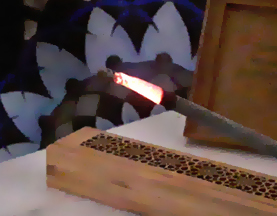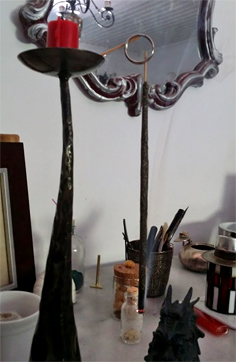Frankincense incense sticks made by Jeomra and Palo Santo + Black Copal incense sticks
For today, I have something special: Frankincense [in German: Weihrauch] incense sticks made in Germany.
It’s nice that incense enthusiasts in this country have the courage and commitment to create something like this.
I bought 2 of the 3 currently available varieties: “Oman” and “Afrika” – the third is called “Somalia”.
In their newsletter, it was said that they are currently working on Sandelholz [sandalwood] and Patchouli sticks – so one can be excited.
In my opinion, these two, and even more so the Palo Santo incense sticks, fall into the category that is often referred to as “resin-on-a-stick”. So they are very resin-heavy incense sticks, which produce a lot of smoke – but usually also have a very long burning time. As far as I know, the term and the associated sticks were invented by Fred Soll – an American incense manufacturer who uses pinyon pine resin as the basic ingredient. (Unfortunately, I haven’t been able to try his creations yet – they are practically unavailable in Europe. In the USA, he even sells them on Amazon.)
Jeomra – now Raeucherwelt.de is one of the retailers from whom I have been buying raw ingredients for a long time. They have some special, rare and hard-to-find incense materials in their range that I have only ever seen at Apothecary’s Garden (which is based in Canada).
The quality of their goods is excellent, but unfortunately, I have to say that I have had problems with incorrect weighing or the wrong packaging unit being delivered a couple of times, which I only noticed through my habitual weight-checking. That’s annoying, but I’m sure it was never intentional, errors were always corrected promptly.
But now finally to the incense sticks:
A pack of 10 sticks costs €8.90, which is around 90ct per piece. They are 20.5cm long, of which 2.5cm are blank. A burning time of 50–60 minutes is specified.
Weihrauch Oman
[There is a more recent article about these incense sticks.]
Ingredients: Beech charcoal from Germany, frankincense from Oman (B. sacra), joss powder from Vietnam, German forest honey, Boswellia sacra essential oil
The sticks are effortless to light and produce an expected amount of soot (caused by the resin and possibly also the essential oil).
They immediately smell strong and intensely of frankincense, in this case the bright, somewhat citrusy tone, typical of B. sacra and the sharp resin aroma that always arises when frankincense (or many other resins) are burned on coal. The aroma is nowhere near as nuanced as when you heat a frankincense of this quality on an incense heater (with a tea light or electric), but it’s a lot better than the smell of frankincense burned on plain charcoal.

I’m absolutely thrilled that you can’t smell a bit of the charcoal. The only nitpick I have, is that the embers become very long when burning – which is a sign that the coal content is a little too high. This also means they might burn faster than necessary.

Weihrauch Afrika
[There is a more recent article about these incense sticks.]
Ingredients: Beech charcoal from Germany, frankincense from Somalia (B. carterii), Ethiopia (B. papyrifer), and Ogaden (B. rivae), Joss powder from Vietnam, German forest honey.
I think, the Afrika sticks don’t burn as quickly and intensely as the Oman ones. The embers also seem a bit shorter to me, but could still be much smaller.
These sticks also have a typical frankincense smell, but it’s darker/deeper than that of Oman. Their aroma is spicier, somewhat tarter, and they don’t have a pronounced citrus note. For me, their smell has a strong association with churches – probably because of the B. papyrifera used, which always smells somehow “oily” and “heavy” to me and, as far as I know, is often used in churches.
When I compare the two varieties directly, the Oman sticks seem a bit sweeter and almost a little fruity, what I didn’t notice initially.
They seem like unequal brothers: Afrika is powerful, robust and down-to-earth – Oman is bright, energetic and ethereal.
When the smoke is gone, both have a subtle, wonderfully delicious sweetness in the aftersmell, that I found very unexpected. I wonder if it’s because of the honey in the recipe.
I always smell this sweet note shortly after lighting a stick, with the first few wafts of fine smoke, but then the smoke becomes more concentrated, this note disappears.
I have a strong suspicion that these incense sticks are far too potent for my relatively small living room (despite the open windows) and that an enormous amount of complexity and olfactory nuances are simply lost to the density. They’re not too strong for me, they don’t oversaturate me, but I think they need a lot more space for their scent to develop its true potential.
I wish these incense sticks came in a coreless format as delicate, thin “Japan style” sticks. But I guess I’ll have to make some myself.
Hats off! I’m honestly impressed and very excited to see what else comes from Jeomra in the future!

Palo Santo + Black Copal
Ingredients: Palo Santo wood powder (Peru), Palo Santo oil, Black Copal
There is no binder specified, which surprises me, and charcoal is not mentioned either.
The sticks are 20cm long, of which 2cm are bare bamboo, what could lead to issues with some holders. On the other hand, you get the maximum amount of incense for the length. Also, they are even thicker than the frankincense sticks.
The description mentions certification as a sustainable product – but not who certified it. Who the actual manufacturer is also remains unknown.
These sticks are not nearly as easy to light as the Frankincense ones.
The common recommendation to light resin incense sticks, is to light it, let the flame sit for 1 to 3 seconds, then blow it out again; this is repeated until the tip shows a decent ember. If you don’t do this and just let it burn, the flame will quickly spread backwards and a lot of the good aroma will be wasted.
When you light them, they really make a lot of soot. It took quite a while for the stick to get an ember, and unfortunately, it repeatedly and rapidly went out again, just after about half a centimetre.
This usually means that too little charcoal (if any) has been added, or the ratio of wood to resin is not correct. Of course, this could very well be a batch problem and doesn’t mean that it’s always the case with these sticks, at least I didn’t find any reference to such issues in the reviews.
In such cases, you can use the “key ring trick”:
Take a key ring (of course, metal clips also work, or cross-tweezers etc.) and use it to clamp the bare end of the stick and hang it upside down to burn it. You have to be a little inventive. Also, please ensure to do this over a fireproof surface. My very improvised setup looked like this:

I stuck the leftover bamboo of a burnt incense stick under a candle, on which I mounted the key ring that held and suspended the stick. Not very secure – admittedly. It is better not to leave such an installation unattended. But it works. After hanging it, it didn’t go out any more and produced an expectable large amount of smoke. Even with the window wide open, you can quickly find yourself in the fog. This is an advantage if you want to use the sticks to smoke-cleanse the house, but that’s again difficult if you have to hold it upside down. Quite annoying.
As far as the scent is concerned, I think they’re good. The copal is in the foreground, with a very pronounced, resinous-foresty aroma. Copal Negro has a very dark, earthy quality, which unfortunately doesn’t come through quite as well here; it’s just a lot of “vaporizing resin” that you smell.
Added to this is the special sweetness of palo santo, and its woodiness, which balances the smell to some degree and gives its character a second dimension.
In case you’re not familiar with palo santo: Please don’t think of this as a classic “woody aroma” – my brief description for palo santo smell is “Kukident/dentist with coconut”. It has a very specific, fresh aspect that, lacking a better comparison, is very close to mint, or related smells, at least something you would smell at the dentist. And then there’s this strange, sweet note that smells like coconut to me.
Many find palo santo unbearable. I’ve read descriptions like “chemical”, “burning rubber”, and “formaldehyde”. It took me years to understand this scent, and even longer to learn to appreciate it. – Though, some people love it straight away.
As intense as the smoke is, it’s never acrid, even if you stand very close to the stick. I would even describe it as quite soft.
The after-smell clearly shows more of the palo santo. The more the smoke disperses, the more noticeable it becomes, until the copal is just a resinous note in the background and eventually disappears completely.
This was my first foray into resin-on-a-stick style incense. Due to the lack of options to compare, I am (for now) foregoing a specific rating.

